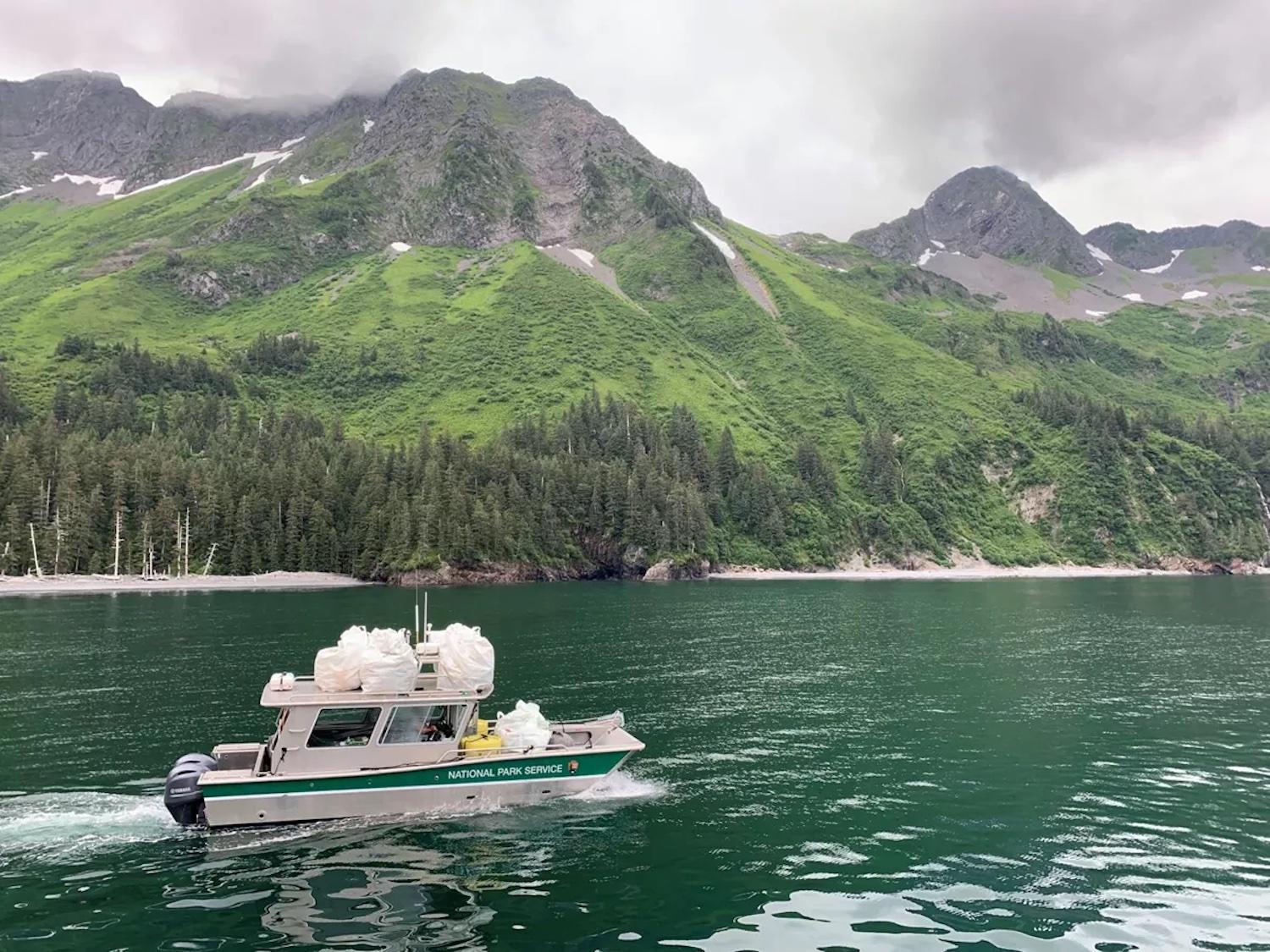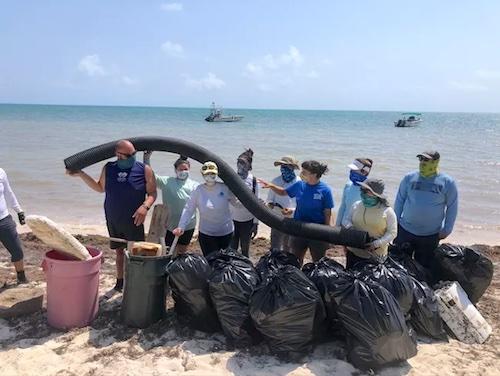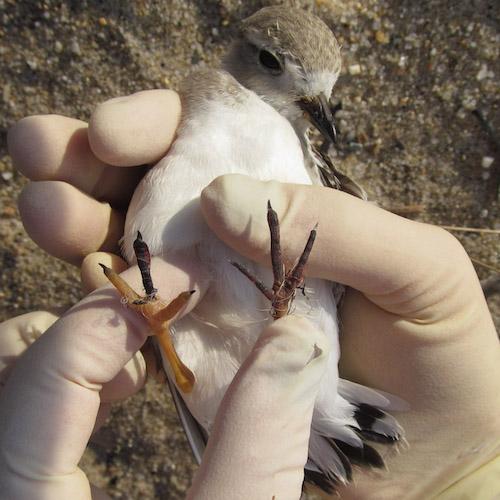
Plastics and other marine garbage is a problem across National Park System units, including Kenai Fjords National Park, where they collect the coastal trash and haul it by boat to Seward for disposal/NPS file
Battles With Plastics Pollution Washing Ashore At National Seashores
By Lori Sonken
Laura Ludwig and her volunteer crew keep finding bright yellow spaghetti-like plastic tubes ranging from 1-inch to five feet long littering Cape Cod National Seashore. The pieces are remnants of explosive shock tubing used last fall when the U.S. Army Corp of Engineers worked on deepening Boston Harbor. Clean-up crews inadvertently lost about four miles of tubing that floated away in the ocean, and Ludwig’s crews found pieces at Race Point Beach in the national seashore.
“It’s pernicious and persistent. We’ll be finding this for years. I guarantee it,” said Ludwig, manager of the Marine Debris and Plastics Program at the Center for Coastal Studies, an independent, nonprofit member-supported organization in Provincetown, Massachusetts, that works to protect and preserve marine ecosystems. Of the 20,000 feet of tubing lost, only 2,000 feet of the lightweight, hollow plastic has been found, and some as far away as the Bay of Fundy.
In addition to being unsightly, the small plastic pieces can be ingested by birds and other wildlife at the national seashore.
Another problem with the plastic is that it does not biodegrade. When discarded pieces of plastic debris, including bottles, bottle caps, cups, bags, and fishing gear, are exposed to sunlight and waves, the plastic breaks into smaller pieces – some less than 5 mm in diameter -- known as microplastics that wildlife can confuse for food. Harmful chemical pollutants can attach to the plastics, increasing the toxicity of the debris consumed by wildlife and marine life and, potentially, humans eating the marine life.

Laura Ludwig with some of the plastic tubing collected at Cape Cod National Seashore/Center for Coastal Studies
Plastic waste enters the oceans at a “staggering” rate – about 8 million tons are dumped in the world’s oceans each year, according to testimony presented by Tony Radoszewski, president and CEO, U.S. Plastics Industry Association, before the House Subcommittee on Water, Oceans, and Wildlife in 2019. This amount is a fraction of the two garbage-truck loads of plastic that the environmental organization Oceana estimates are dumped into the ocean each minute of every day.
At the time, Deb Haaland chaired the House Subcommittee on National Parks, Forests and Public Lands and participated in the 2019 hearing. Now Secretary of the Interior, Haaland tweets and says she carries a reusable water bottle and avoids single-use plastics that could end up in national parks and the ocean.
Last summer, 300 environmental, business, animal rights, religious, and other organizations called on Haaland to eliminate the sale or distribution of single-use plastics in national parks. So far, she has not taken public steps to direct parks to stop selling plastics, and her office did not respond to an email from the Traveler asking about her plans.
“It’s going to take all of us working with the National Park Service to try and remove single-use plastics in national parks,” said Sarah Gaines Barmeyer, the senior managing director of conservation program for the National Parks Conservation Association.
Former NPS director Jon Jarvis issued a policy in 2011 allowing park superintendents to halt the sale of disposable plastic water bottles if they informed visitors of the environmental impact of plastics, sold reasonably priced reusable bottles that could be filled at bottle stations within the park, and received approval from regional directors. The Trump administration rescinded the policy in 2017. While companion legislation introduced by Senator Jeff Merkeley (D-Oregon) and U.S. Rep. Mike Quigley (D-Illinois), calling on the National Park System to reduce disposable plastic products and, if applicable, eliminate the sale and distribution of disposable plastic products, Congress reportedly wants the Biden administration to take the lead.
Hugh Hawthorne, superintendent at Assateague Island National Seashore in Maryland and Virginia, might consider asking the park’s concessionaire to refrain from selling water in plastic bottles in future contracts. But he said most parks will be reluctant to do this without a mandate from Washington because the issue “is a hot potato.”
Mysterious Yellow Tubing Washes Onto Cape Shores from Lower Cape TV on Vimeo.
Meanwhile, plastic accounts for up to 90 percent of the trash floating in the oceans and littering shores. Vanessa McDonough, fishery and wildlife management biologist at Biscayne National Park in Florida, has seen sea turtles strangled and entangled by the polypropylene lines used in commercial traps, along with countless birds harmed or killed due to entanglement in monofilament fishing line. An endangered smalltooth sawfish was injured after it, too, got tangled in polypropylene fishing line. The same story holds true for reef organisms, including sponges, soft corals, and stony corals killed or injured by nets as well as fishing and trap lines.
Like parks across the country, Biscayne involves its staff and volunteers in trash removal efforts.
Last month the park “removed 30,881 pounds of debris from sea turtle nesting beaches and mainland shoreline habitats, doing so with the help of 251 different volunteers,” from across the country, said McDonough in an email.
In a short-term study last year, 77 percent of the 3,402 pounds of garbage collected during a six-day period at Biscayne was plastic, and there also were illegally dropped anchors that lodged in the segment of Florida’s Coral Reef that lies within the park, smashing corals, sponges, and other organisms. This year, the amount of trash collected at Biscayne is expected to be greater than the 70,000 pounds volunteers picked up throughout 2021. So far, more than 37,000 pounds of debris has been collected .
“Volume-wise, this debris is overwhelmingly plastic. By weight, it is also substantial, “ she said.
Over the last five years, Biscayne has also tallied more than 2,600 balloons found on sea turtle nesting beaches. Similarly, at Fire Island National Seashore in New York, Mylar balloons are “all over the beach, all the time” said Michael Bilecki, the seashore’s chief of resources management.

Volunteers annually collect thousands of pounds of garbage at Biscayne National Park/NPS file
Marine debris also is negatively impacting foraging and nesting habitat for shorebirds and sea turtles at Cape Hatteras National Seashore in North Carolina. At Padre Island National Seashore in Texas, sea turtles have to navigate through the trash to lay eggs on the beach and their hatchlings have to crawl around the trash on their way to the ocean. This is stressful for animals who spend most of their lives in the ocean, said Kelly Taylor, Padre Island’s public information officer.
Since 2019, Padre Island has worked with the National Oceanic and Atmospheric Administration to annually collect debris every five miles along the seashore’s 60-mile-long coast. “We’ve found everything from fishing nets to plastic dinosaur toys, but the most commonly collected items are single-use plastics, particularly bottle caps,” said Shelley Todd, chief of resource management.
Plastic bottle litter is not a significant problem at Assateague Island, said Superintendent Hawthorne. Visitors to Assateague are encouraged to refill their own bottles at water-filling stations in the park.
Another source of trash at Assateague are tires, likely coming from a manmade offshore reef, and which can be an eyesore at the national seashore. At one beach clean-up effort, the park filled three full-size pickup trucks with tires. But the biggest concern at Assateague are the birds that get wrapped in discarded fishing lines.
“They are probably going to drown before someone notices them,” said Hawthorne, especially during the offseason when the park staff is smaller and there are fewer visitors to report sightings.
Plastic bottles are generally not a problem at Cumberland Island National Seashore in Georgia, either. Most visitors take their trash with them when they depart the park that sits on an island off the coast.
But “trash, including plastic, washes up more frequently during the shrimping season when some refuse is dumped off of boats. A tropical storm may also bring trash up on the beach, as floodwaters wash through developed areas,” wrote Jill Hamilton-Anderson, the park’s interpretation and education manager, in an email.
A study led by Stefanie L. Whitmire at Clemson University from 2015-2017 found widespread plastic pieces in the sand on beaches in 35 national park units on the Atlantic and Pacific oceans and Great Lakes, including in remote locations in Alaska and American Samoa. Apostle Islands National Lakeshore in Wisconsin had some of the highest plastic loads, likely coming from nearby St. Louis River.
“The presence of microplastics in the marine environment poses risks to wildlife and human health,” Whitmire’s study found.

Wildlife, such as this piping plover at Cape Cod National Seashore, can become entangled in discarded fishing line/NPS
Some parks are voluntarily taking steps to remove the sale of plastic items. Padre Island removed vending machines where visitors could purchase drinks in plastic bottles. Cape Cod National Seashore has transitioned its concessionaire away from single-use plastics to paper straws, wooden utensils, and recycled paper products for serving foods. Beverages are packed in cartons or metal cans. Park stores at Cape Cod discontinued selling single-serve bottles, and reusable totes have replaced plastic bags.
Radoszewski, the plastic industry’s president testifying before Congress in 2019, disagrees with this approach. “In many cases, what is broadly considered a ‘single-use’ plastic product, is the more environmentally sound choice when considering the manufacturing process, shipping, and recyclability over the life of the product,” he said. He touted the environmental benefits plastic bags have compared to paper, woven polypropylene, and cotton/canvas bags that he claimed have a higher carbon footprint than traditional plastic bags.
Laura Figueroa, postdoctoral fellow at the University of Massachusetts Amherst, said factors in addition to carbon must be considered. “What about malnourished sea turtles that eat plastic bags resembling edible jellyfish or shore birds that choke on plastic bottle caps? We must think beyond just carbon and account for the numerous insidious impacts that plastics have on biodiversity and people.”
Traveler postscript: National seashores, Great Lake park units, and parks in Alaska that touch the Pacific are not the only areas of concern in the National Park System when it comes to plastics pollution. A 2020 study determined that more than 2 million pounds of microplastics, the equivalent of 123 million plastic bottles, settles on national parks and other public lands in the West each year. The Oceanic Society has seven recommendations for reducing plastic waste. You can find them here.

Comments
What would happen if everyone who cares began going to our favorite restaurants, grocery stores, and other places and insisted on buying only products that come in non-plastic wraps and containers?
And the tides of plastic in our oceans and other waterways provide a ready-made argument to respond when fans of fossil fuels try to use their shopworn argument that "humans can't possibly change the atmosphere enough to cause Global Warming."
Polution is everywhere, and not only plastic polution. We just came back from a two month trip to the US national parks in the south and west. There is trash everywhere, not just in the water. We saw plastic and non plastic trash alongside the roads and on backcountry trail hikes. It's alongside backcounty trails inside Yosemite, Death Valley, Sequoia, Joshua Tree, and of course along the beaches of Redwoods National and State Parks. There are plastic bags hanging on brush and trees, bottle caps left in the back country, the remains of face masks at every parking lot and nearly every campground. Even syringes on the beach. Our supposedly most remote places are now polluted by garbage. There are food wrappers, bottles and cans, storage containers, signs, boxes, car parts, as well as boat parts, rope, medical waste, clothing and so many other things too numerous to mention. We even saw whole RVs left abondoned to rot in a national forest. Most of this junk is made of plastic or plastic coated paper, but there is also glass and aluminium and other metal. But it's the stuff that doesn't disolve in water or rust that seems to be the worst: plastic and aluminum is everwhere! We need attack this mess with heavy penalties for littering, reducing the use of plastic where alternatie materials work and maybe most importantly providing monetary incentives to get people to collect and dispose of their trash properly, especially plastic, glass and aluminum! Instead of continuing the failed policy carry in/carry out at parks and other places (which 25% of people ignore), we need to provide trash recepticals, and the budget to empty them. Lets face it carry in/out is a cop out driven by budget constraints by administrators who've found an easy to balance the books. I should know, I was budget analyst at the Department of Commerce for 30 years.
How can we eliminate the use of plastic garbage bags used to collect water-borne plastic pollution? The pictures in this article show only plastic bags containing plastic pollution. There must be a better way!
You are very mistaken when you wrote that "At Padre Island National Seashore in Texas, sea turtles have to navigate through the trash to lay eggs on the beach and their hatchlings have to crawl around the trash on their way to the ocean. This is not true! Trash does wash in and certainly is a problem to be solved but nesting sea turtles are not "navigating trash". There are more washed in logs and branches to navigate than smaller plastic items. I was most horrified to read that hatchlings "have to crawl around trash". Hatchlings are released under protective conditions. For public releases, beaches are raked of seaweed and sticks and perhaps some items of plastic before they crawl to the water. For non-public releases a beach area is selected with many factors in mind; ghost crabs, gulls, tides and Sargassum being most important. I have been a volunteer with Padre Island National Seashore for 17 years and have released thousands upon thousands of hatchlings and NEVER has one had to crawl around trash.
"Releases" aren't the only way turtles enter and exit the water. Ever thought of the turtles that nest and are not observed, and their hatchlings? This happens at the Seashore and in many other locales. I think you missed the point of this story. Sorry. The increase in plastic pollution is real at the Seashore. After living there until 2001 and then returning for a visit in 2019, I was shocked to see the difference and the amount of plastic trash that was now present everywhere, including high up in the dunes right in front of the visitor center as well as down island. I filled a bag in no time. I wasn't the only one filling bags that day, but it felt like the fight against windmills. From a former long-term PAIS volunteer who remembers the humble beginnings of the turtle program.
Trash continues to be a problem on PAIS and the coast of Texas, I most certainly agree. But I wish that were the only problem being encountered by the
sea turtle program currently. As one volunteer to another, are you aware of the issues regarding the attempts to dismantle what has taken 40 years of hard work?
Mareen Hurlow - apparantly you have never been down island in your 17 years as a volunteer, because it is a flat out lie "there are more washed in logs and branches to navigate than smaller plastic items." If that were actually the case then there woould be no need for events like the Big Shell Clean Up that happens every year and has happened every year for 25+ years. There would be no need for more than 500 volunteers to go out on the beach and easily remove 30+ tons of trash from the beach. 1% of one species of turltle nests at PINS and its very nice that you "rake the beach" before you release hatchlings, but what about the 99% of the population that nest and hatch on Mexico's beaches? Do they have raked beaches? What about species of turtles that nest on other beachs in other parts of the country and other parts of the world? Do they not matter? Apparently not. The mere fact that you supposedly read the whole article and you felt compelled to have to point out the PINS turtles are released on a clean beach tells me that you are really, really out of touch with what is going on in the world around you. I encourage you to volunteer at another park with sea turtles to see what obstacles turtles are faced with when they hatch because no one is there to rake the beach for them. I also encourage you participate in the next Big Shell Clean Up because raking those beaches for turtle releases has given you a false sense of the stupid amount of trash that is out there.